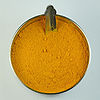I know this stuff looks like marijuana but it could possibly work to get rid of your unwanted hair.
1. Origin
2. How it works
3. How to make it
1.Turmeric grows wild in the forests of Southeast Asia. It has become the key ingredient for many Indian, Persian and Thaidishes such as in curry and many more.
In Indonesia, the turmeric leaves are used for Minangese or Padangese curry base of Sumatra, such as rendang, sate padang and many other varieties.
Although most usage of turmeric is in the form of root powder, in some regions (especially in Maharashtra), leaves of turmeric are used to wrap and cook food. This usually takes place in areas where turmeric is grown locally, since the leaves used are freshly picked. This imparts a distinct flavor.
In recipes outside South Asia, turmeric is sometimes used as an agent to impart a rich, custard-like yellow color. It is used in canned beverages and baked products, dairy products, ice cream, yogurt, yellow cakes, orange juice, biscuits, popcorncolor, sweets, cake icings, cereals, sauces, gelatins, etc. It is a significant ingredient in most commercial curry powders. Turmeric is mostly used in savory dishes, as well as some sweet dishes, such as the cake sfouf.
Although usually used in its dried, powdered form, turmeric is also used fresh, much like ginger. It has numerous uses in Far Eastern recipes, such as fresh turmeric pickle, which contains large chunks of soft turmeric.
Turmeric (coded as E100 when used as a food additive) is used to protect food products from sunlight. The oleoresin is used for oil-containing products. The curcumin/polysorbate solution or curcumin powder dissolved in alcohol is used for water-containing products. Over-coloring, such as in pickles, relishes, and mustard, is sometimes used to compensate for fading.
In combination with annatto (E160b), turmeric has been used to color cheeses, yogurt, dry mixes, salad dressings, winter butter and margarine. Turmeric is also used to give a yellow color to some prepared mustards, canned chicken broths and other foods (often as a much cheaper replacement for saffron).
 |
| Turmeric powder is used extensively in South Asian cuisine. |
Turmeric is widely used as a spice in South Asian and Middle Eastern cooking. Many Persian dishes use turmeric as a starter ingredient for almost all Iranian fry ups (which typically consist of oil, onions and turmeric followed by any other ingredients that are to be included). In Nepal, turmeric is widely grown and is extensively used in almost every vegetable and meat dish in the country for its color, as well as for its medicinal value. In South Africa, turmeric is traditionally used to give boiled white rice a golden color.
In Goa and Dakshina Kannada (Karnataka state, India), turmeric plant leaf is used to prepare special sweet dishes, patoleo, by layering on the leaf — rice flour, and coconut-jaggery mixture, and then closing and steaming in a special copper steamer (goa).
2. Cosmetics
Turmeric paste is traditionally used by Indian women to keep them free of superfluous hair and as an antimicrobial. Turmeric paste, as part of both home remedies and Ayurveda, is also said to improve the skin and is touted as an anti-aging agent. Turmeric figures prominently in the bridal beautification ceremonies of India, Bangladesh, and Pakistan. Staining oneself with turmeric is believed to improve the skin tone and tan. Turmeric is currently used in the formulation of some sunscreens.
The government of Thailand is funding a project to extract and isolate tetrahydrocurcuminoids (THC) from turmeric. THCs are colorless compounds that might have antioxidant and skin-lightening properties, and might be used to treat skin inflammations, making these compounds useful in cosmetics formulations.
3. Home Remedies
- Indian homes have numerous beauty recipes that include turmeric. These recipes not only prevent excessive hair growth but also lighten and exfoliate the skin.Remove unwanted hair from face, arms and legs by applying a paste of 1 tbsp. of black gram flour with 1 tsp. of yogurt and a pinch or turmeric powder, recommends Hair-n-skin-care.com. Evenly apply to face, relax and allow it to dry. Once completely dried, gently scrub the paste off. Turmeric removes hair, sanitizes the face and adds glow. Apply baby or almond oil to soothe skin.Gram flour is a natural cleanser and scrub, says Yogawiz.com. Using gram flour alone or with turmeric reduces hair growth.Many mix turmeric powder with milk and add directly to face, arms and legs. A paste of raw turmeric along with rock salt also acts as hair inhibitor. Hairremoval.in recommends using 1/4 tsp. of turmeric powder mixed with the same amount of papaya powder, gram flour, 2 tsp. of mustard oil along with a couple of drops of essential oils, as a recipe to remove unwanted hair.

_W_IMG_2440.jpg/190px-Curcuma_longa_(Haldi)_W_IMG_2440.jpg)

No comments:
Post a Comment